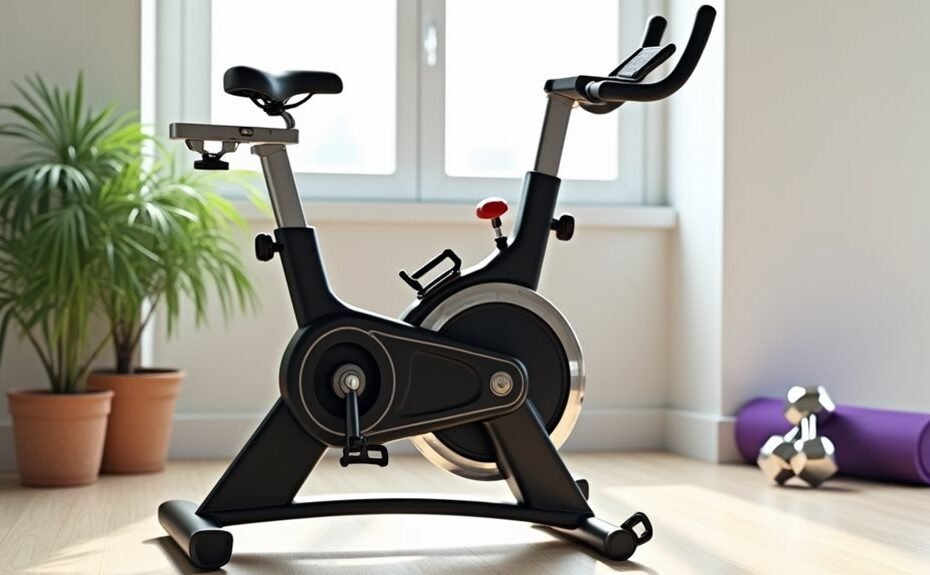Did you know that static bikes can provide up to 85% of the cardiovascular benefits of outdoor cycling while overcoming weather limitations and safety worries? I've spent years researching and testing different indoor cycling techniques, and I've found that most individuals aren't maximizing their static bike workouts. Whether you're a novice seeking to enhance your heart health or a seasoned cyclist striving for optimal performance, comprehending the science behind successful indoor cycling can revolutionize your cardio regimen. Let me demonstrate how to unleash your full potential and conquer your fitness objectives on a static bike.
Key Takeaways
- Set up your static bike correctly with proper saddle height and resistance levels to maximize cardiovascular benefits while minimizing injury risk.
- Incorporate high-intensity interval training with alternating sprints and recovery periods to boost heart health and calorie burn.
- Monitor heart rate zones during workouts using smart devices to ensure optimal intensity and track cardiovascular improvements.
- Follow structured training plans that combine endurance rides, speed work, and recovery sessions for comprehensive heart fitness.
- Maintain proper form by engaging core muscles and focusing on smooth pedaling motions while gradually increasing workout intensity.
Understanding Static Bike Benefits
Static bikes are game-changers for achieving fitness goals without the hassle of outdoor cycling. I'll tell you why they're your secret weapon for crushing cardio: they're scientifically proven to boost your heart health while being incredibly safe and accessible. Trust me, your cardiovascular system will thank you. Indoor cycling research shows stationary bikes can improve overall fitness for people of all age groups.
Let's break down what you're getting. First, you'll enhance your heart health – we're talking improved blood flow, lower blood pressure, and more elastic blood vessels. I've seen the research: cyclists have markedly lower rates of heart disease. Plus, you're building serious muscle power. Your legs, glutes, and core will transform as you push through those resistance levels. You'll get a complete lower body workout targeting everything from calves to hamstrings. Studies show that regular sessions can boost memory function and improve brain performance.
Here's the kicker – you'll torch calories like nobody's business. We're looking at 600+ calories per hour, and your body keeps burning for up to 14 hours after. And the best part? You won't strain your joints doing it.
Rain or shine, day or night, you can hop on and crush your workout. No traffic, no weather excuses, just pure, efficient cardio gains.
Setting Up Your Bike
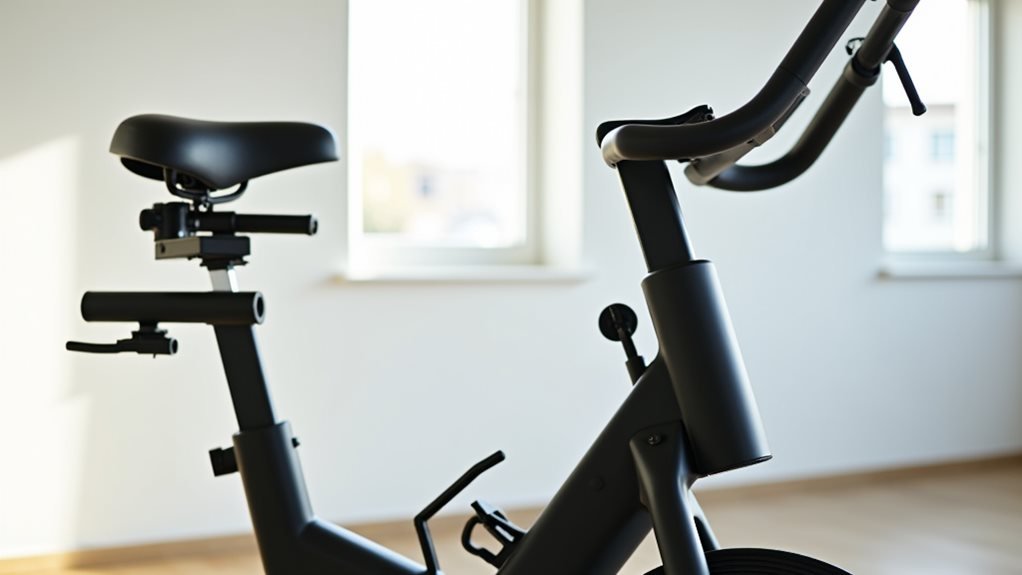
Now that you know the incredible benefits of static bikes, let's get you properly set up for maximum results. I'll walk you through the critical adjustments that'll transform your ride from awkward to awesome.
Start with your saddle height – it should align with your hip bone when you're standing next to the bike. When you're seated, your leg needs a slight bend (25-35 degrees) at the knee. If you're fully extending, you're too low. Trust me on this one. Position your feet with the balls of feet secured firmly in the pedal straps. Cycling shoes can provide even better foot placement control.
Next, let's nail your positioning. Your front knee should hover directly above the ball of your foot when the pedals are at 3 and 9 o'clock. Slide that seat forward or back until you're aligned perfectly.
For handlebars, I recommend keeping them level with or slightly above your saddle, especially if you're new to this. Adjustable resistance levels allow you to customize your workout intensity as you become more comfortable with your bike setup.
Mastering Proper Cycling Form

Three key elements make up proper cycling form: posture, pedaling technique, and weight distribution. Let me break down each component so you'll nail your form from day one.
First, your posture. I want you to keep that back flat and chest up – no compromises. Think of your spine as a steel rod. Your neck should align perfectly with it, and those shoulders? Keep them wide and proud. Setting up your saddle height correctly is essential for maintaining proper alignment. Muscle engagement is maximized when you maintain a strong, stable core during your cycling workout. Trust me, slouching isn't doing you any favors.
Now, let's talk pedaling. You'll want a slight bend in those knees at the bottom of your stroke – I'm talking minimal here. Push through the center of your foot and think circular motions, not stomping. It's like drawing perfect circles with your feet. Keep your feet flat on the pedals to ensure balanced muscle engagement throughout your workout.
Progressive Heart Rate Training
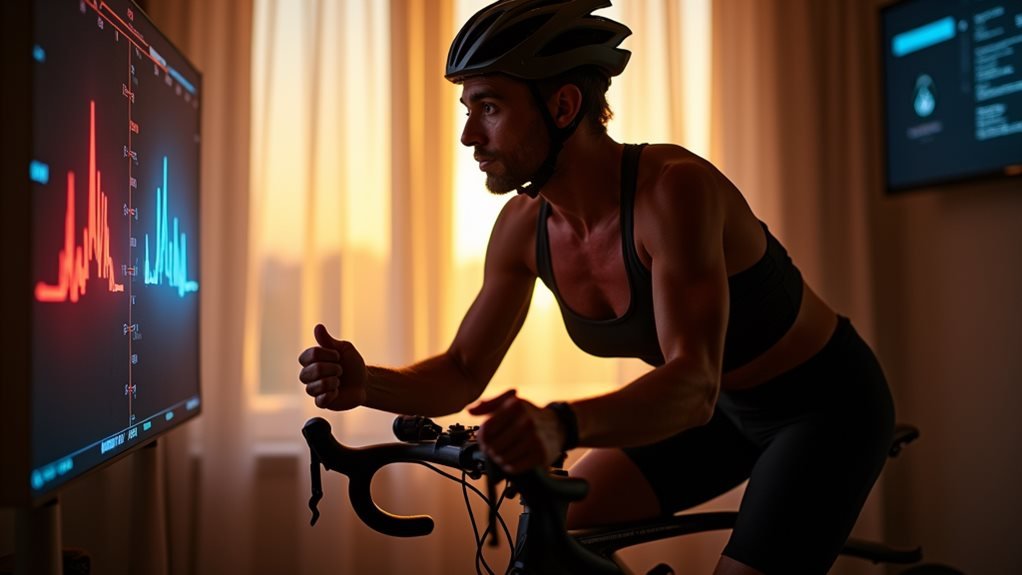
With proper form mastered, let's focus on maximizing your cardio potential through heart rate training. I'll show you how to leverage heart rate zones to crush your fitness goals, and trust me – it's more scientific than you'd think. Using smart trainer technology helps provide precise resistance control for targeted zone training. Heart rate measurement offers a simple and cost-effective way to track your progress.
First, we'll nail down your maximum heart rate through a gut-busting 6-minute all-out effort. Sound fun? No, but it's necessary. Once we've got your numbers, we'll map out your training zones.
Zone 1 (below 50% MHR) is your recovery buddy, while Zone 2 (50-60% MHR) is where you'll build that vital endurance base.
Here's the kicker – I won't let you jump straight into high-intensity work. We're building progressively, starting with 2-3 challenging sessions weekly. Your other rides? Pure endurance. And don't get cocky with those high-aerobic sessions – cap them at 6-8 hours weekly, or you'll crash and burn.
Designing Effective Workout Plans
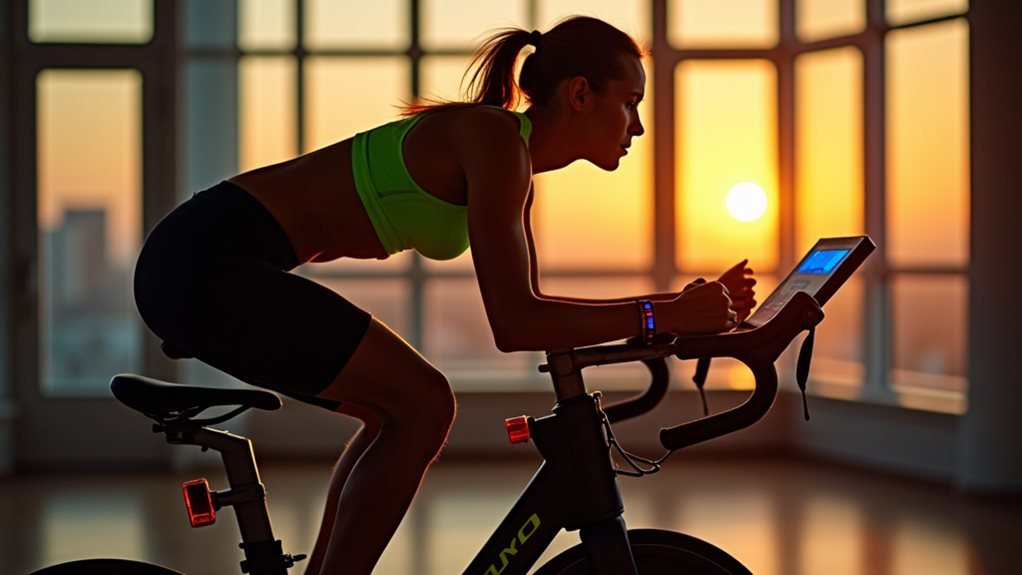
Since you've mastered heart rate zones, let's explore creating a structured training plan that'll take your cycling to the next level. I'll show you how to build a program that maximizes every minute on your static bike, starting with a solid base phase to boost your aerobic fitness and FTP.
Your week should include three key components: high-intensity intervals (I love scheduling these after rest days), endurance sessions, and strategic recovery. The program uses science-based machine learning to continuously adapt to your performance. Beginners should focus on a six-week foundation to develop consistency and proper form.
I'm talking about mixing threshold ramps with zone 3 work, punctuated by zone 5 bursts that'll make your legs scream – but trust me, that's where the magic happens.
Don't worry if you're time-crunched. I'll help you choose between low, mid, or high-volume plans based on your schedule. Remember, consistency trumps sporadic hero sessions every time. Use Plan Builder tools to customize your training, but keep it flexible – life happens, and your plan should adapt accordingly.
Track your progress religiously. If you're not monitoring your gains, you're just guessing. And please, don't skip recovery days – they're not optional, they're essential for preventing burnout and building real fitness.
Overcoming Indoor Cycling Plateaus
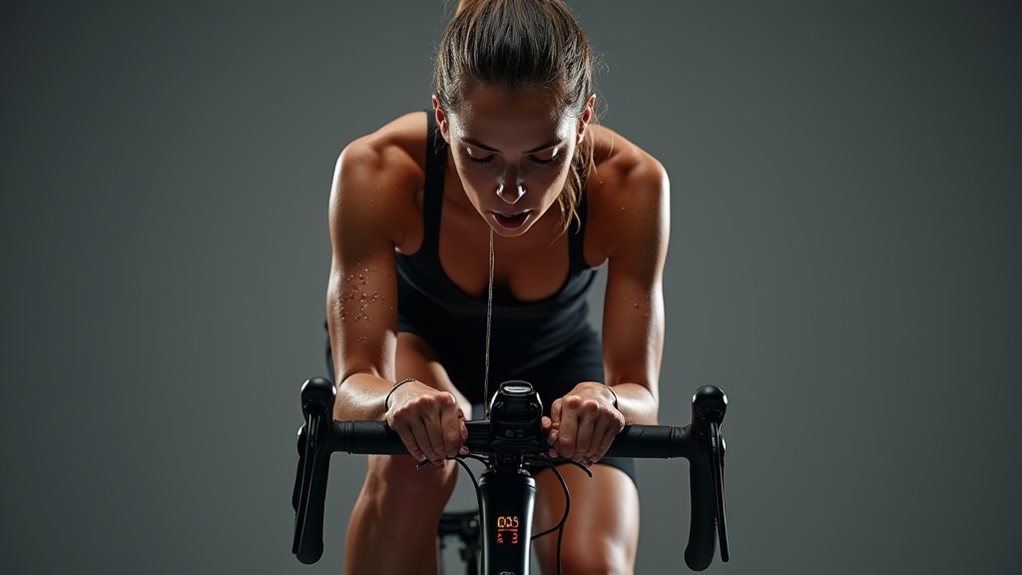
Hitting a plateau can feel like cycling through quicksand – frustrating and seemingly impossible to escape. I'm here to tell you that breaking through requires strategic intensity management, not just mindlessly cranking up resistance.
Here's your escape plan:
First, boost your time-at-intensity. If you're doing 60 minutes at lactate threshold weekly, bump it to 70. Trust me, that 25% increase will wake up your system.
Next, embrace the pain of speed work – I'm talking 30-second all-out sprints followed by 30 seconds of blessed recovery. Repeat until your legs scream (or six minutes, whichever comes first).
But don't get caught in the "more is better" trap. I've seen too many cyclists crash and burn that way. Instead, maximize your current training hours through structured workouts and sweet-spot training at 88-90% FTP.
And for heaven's sake, respect recovery. If you're dragging through workouts like a zombie, you need rest, not another interval session. Track everything, fuel properly, and remember: plateaus aren't permanent unless you let them be.
Tracking Cardiovascular Improvements
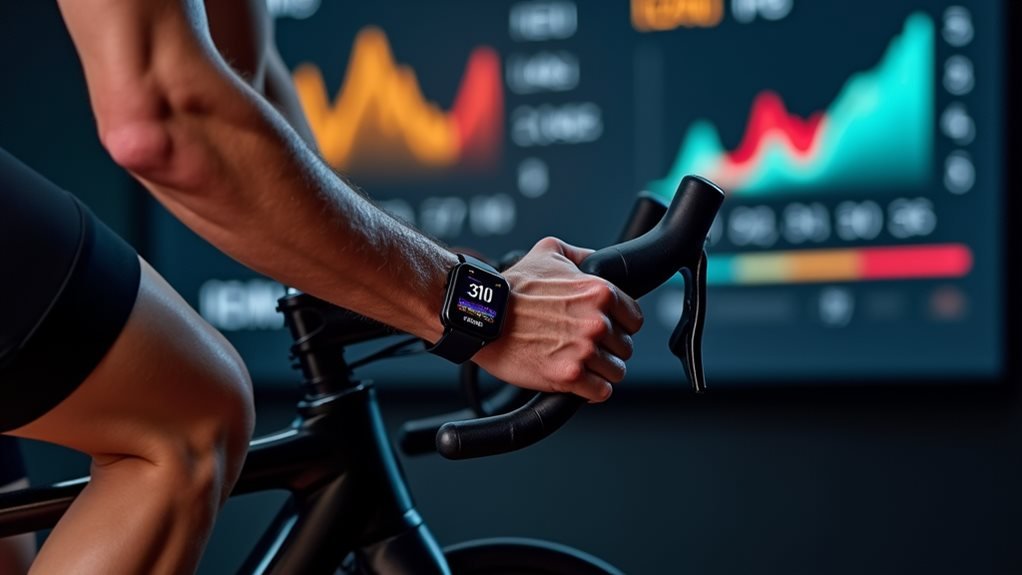
Breaking through plateaus leads naturally to measuring your progress – and today's tech makes this easier than ever. I'm seeing more cyclists leverage wearable devices to track their cardiovascular improvements with incredible precision. Using photoplethysmography and sophisticated algorithms, modern smartwatches and fitness trackers deliver clinical-grade heart rate monitoring with less than 5% error margins.
Here's what you need to track for maximum gains:
- Calculate your Personal Activity Intelligence (PAI) score – hitting 100 points weekly can slash your cardiovascular mortality risk by up to 23%
- Monitor your heart rate variability trends using wearable ECG functions to detect early signs of overtraining
- Track your power output-to-heart rate ratio over time – it's your best indicator of cardiovascular efficiency
- Log your recovery heart rate at 1, 3, and 5 minutes post-workout to measure fitness improvements
I've found that combining these metrics with AI-powered analysis gives you unprecedented insight into your cardiovascular health. You'll spot patterns in your training response that would've been impossible to detect just a few years ago. Remember: what gets measured gets improved.
Frequently Asked Questions
Can Cycling on a Static Bike Worsen Existing Lower Back Pain?
I want you to know that cycling on a static bike can worsen back pain if you have poor posture, incorrect bike setup, or tight hip flexors.
How Does Static Bike Cardio Compare to Swimming for Joint Health?
I've found both activities excellent for joint health. While static bikes provide controlled, low-impact movement, swimming offers unique buoyancy benefits. Either choice will protect your joints during exercise.
Should I Eat Before or After My Static Bike Workout?
I recommend eating a small snack 30-60 minutes before your static bike workout and a balanced meal within an hour after. This timing helps fuel your ride and supports recovery.
Why Do My Feet Go Numb During Longer Static Bike Sessions?
I've found foot numbness during static cycling usually comes from tight shoes, poor cleat position, or restricted blood flow. Try loosening your shoes and adjusting your foot position to relieve pressure.
Can Static Bike Training Help Improve Outdoor Cycling Performance?
I'll tell you that static bike training will boost your outdoor cycling performance through consistent power output, targeted interval training, and muscle endurance development – all without weather or traffic interruptions.
